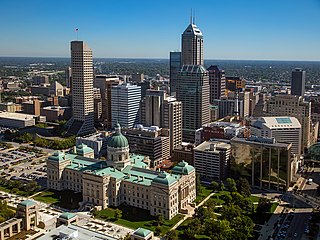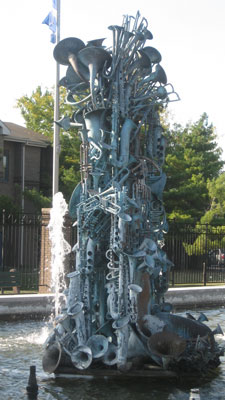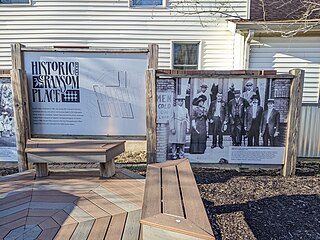
Indiana University–Purdue University Fort Wayne (IPFW) was a public university in Fort Wayne, Indiana. Founded in 1964, IPFW was a cooperatively managed regional campus of two state university systems: Indiana University and Purdue University. IPFW hit its highest enrollment in 2014, with 13,459 undergraduate and postgraduate students in nine colleges and schools, including a branch of the Indiana University School of Medicine. During its last academic year (2017–2018), IPFW had a total enrollment of 10,414 students. IPFW offered more than 200 graduate and undergraduate degree programs through IU or Purdue universities. The university's 14 men's and women's athletic teams competed in Division I of the NCAA Summit League.

Indiana University–Purdue University Indianapolis, commonly referred to as IUPUI, is a public research university in Indianapolis, Indiana, United States. It is a collaboration between Indiana University and Purdue University that offers undergraduate, graduate, and professional degrees from both universities. Administered primarily through Indiana University as a core campus and secondarily through Purdue University as a regional campus, it is Indiana's primary urban research and academic health sciences institution. IUPUI is located in downtown Indianapolis along the White River and Fall Creek.

Herron School of Art and Design, officially IU Herron School of Art and Design, is a public art school at Indiana University–Purdue University Indianapolis (IUPUI) in Indianapolis, Indiana. It is a professional art school and has been accredited by the National Association of Schools of Art and Design since 1952.

The Purdue University system is a public university system in the U.S. state of Indiana. A land-grant university with nearly 75,000 students across five institutions comprising six physical campuses, a statewide technology program, extension centers in each of Indiana's 92 counties, and continuing education programs. Additionally, there are another ~44,000 students enrolled in an online university. Each university in the system maintains its own faculty and admissions policies which are overseen by the Purdue University Board of Trustees. Purdue's main campus in West Lafayette is the best-known, noted for its highly regarded programs in engineering and adjacent subjects.

Hinkle Fieldhouse is a basketball arena on the campus of Butler University in Indianapolis, Indiana. Completed in early 1928, it was the largest basketball arena in the United States until 1950. The facility was renamed Hinkle Fieldhouse in 1966 in honor of Butler's longtime coach and athletic director, Paul D. "Tony" Hinkle. It is the sixth-oldest college basketball arena still in use. Added to the National Register of Historic Places in 1983 and designated a U.S. National Historic Landmark in 1987, Hinkle Fieldhouse is sometimes referred to as "Indiana's Basketball Cathedral."
Indianapolis has seven designated neighborhoods as Cultural Districts, first established in 1999: Broad Ripple Village; Mass Ave; Fountain Square; Wholesale District; Canal and White River State Park; Indiana Avenue; and Market East. The purpose of these designations was to capitalize on cultural institutions within historically significant neighborhoods unique to the city's heritage for economic development and revitalization.

Downtown Indianapolis is a neighborhood area and the central business district of Indianapolis, Indiana, United States. Downtown is bordered by Interstate 65, Interstate 70, and the White River, and is situated near the geographic center of Marion County. Downtown has grown from the original 1821 town plat—often referred to as the Mile Square—to encompass a broader geographic area of central Indianapolis, containing several smaller historic neighborhoods.

The IUPUI Jaguars are the 18 intercollegiate teams that represent Indiana University–Purdue University Indianapolis, in Indianapolis, Indiana, U.S. They compete in the National Collegiate Athletic Association's Division I. On July 1, 2017, IUPUI left the Summit League to move to the Horizon League in all sports. The Jaguars were formerly known as the IUPUI Metros.

IU Michael A. Carroll Track & Soccer Stadium is a 12,100-seat soccer and track and field stadium located in Indianapolis, Indiana, United States. It is the home of the Indiana University-Purdue University Indianapolis Jaguars track and field and soccer teams. It was also the original home of the Indy Eleven.

Arsenal Technical High School, commonly referred to as Tech or Arsenal Tech, is a public high school in Indianapolis, Indiana, United States, which is run by the Indianapolis Public Schools district. The school is located on a 76-acre (31 ha), multiple building campus east of downtown Indianapolis, and is the only such type school in Indiana.

Indiana University Natatorium is a swimming complex on the Indiana University-Purdue University Indianapolis campus in Indianapolis, Indiana, United States. It also serves as the home of the IUPUI School of Health & Human Sciences with its offices on the second level and the Polaris Fitness Center on the first level. The Human Performance Lab is housed in the basement of the Natatorium building.

Lockerbie Square Historic District is a national historic district on the National Register of Historic Places within Indianapolis, Indiana, listed on February 23, 1973, with a boundary increase on July 28, 1987. It is noted for its Federal, Italianate, and Queen Anne style architecture. The original platting of Lockerbie Square, done by Jannett Smith Lockerbie McOuat and named for her father, Scottish immigrant George Murray Lockerbie, was between 1847 and 1850. The 1960s saw an immense effort to save the buildings within the district, becoming the first historic district in Indianapolis. Many of the buildings date from 1855 to 1930. James Whitcomb Riley, famed Hoosier poet, lived in the district for over two decades. He was known to give candy to local children on his regular walks.

Jammin' on the Avenue is an outdoor sculpture by American artist John Spaulding. It is located on the border of the Indiana University-Purdue University Indianapolis (IUPUI) campus, which is near downtown Indianapolis, Indiana, at the intersection of Indiana Avenue, North Street, and Blackford Street. The historic Lockefield Gardens apartments flank the sculpture to its back. Madam Walker Legacy Center is located across the street. This sculpture is documented in the Smithsonian's Save Outdoor Sculpture! database, which is the inspiration for this project.

Untitled (Jazz Musicians) is an outdoor sculpture by American artist John Spaulding. It is located on the border of Indiana University-Purdue University Indianapolis (IUPUI) campus, near downtown Indianapolis, Indiana, at the corner intersection of Indiana Avenue and West Street. The sculpture faces the historic Madam Walker Legacy Center, which is located across the street.

The Bethel A.M.E. Church, known in its early years as Indianapolis Station or the Vermont Street Church, is a historic African Methodist Episcopal Church in Indianapolis, Indiana. Organized in 1836, it is the city's oldest African-American congregation. The three-story church on West Vermont Street dates to 1869 and was added to the National Register in 1991. The surrounding neighborhood, once the heart of downtown Indianapolis's African American community, significantly changed with post-World War II urban development that included new hotels, apartments, office space, museums, and the Indiana University–Purdue University at Indianapolis campus. In 2016 the congregation sold their deteriorating church, which will be used in a future commercial development. The congregation built a new worship center at 6417 Zionsville Road in Pike Township in northwest Indianapolis.
The following is a timeline of the history of the city of Indianapolis, Indiana, United States.

Independent Turnverein, also known as the Hoosier Athletic Club and Marott Building, is a historic Turnverein clubhouse located at Indianapolis, Indiana. It was built in 1907 and consists of a main three-story brick pavilion connected by a two-story section to a second three-story brick pavilion. It has Prairie School and American Craftsman design elements, including a red tile hipped roof. It features paneled and decorated pilasters, a second floor Palladian window, and limestone decorative elements. The building was remodeled in 1946.

Ransom Place Historic District is a national historic district in Indianapolis, Indiana, United States. The district consists mainly of a six-square block in a historically Black residential section of Indianapolis, located just one block from Indiana Avenue. It was originally developed during the 1880s and 1890s, coinciding with the growth of Indiana Avenue as the central commercial district for Indianapolis's Black population at that time. It was listed on the National Register of Historic Places in 1992.
The Indiana University School of Nursing is an academic college of higher education connected to Indiana University with its main research and educational facilities on the Indiana University – Purdue University Indianapolis campus and at Indiana University Bloomington. It is known for its nursing research and education, scholarship of teaching and nursing practice, and for its collaborations with IU hospitals and clinical partners. Established in 1914 as the Indiana University Training School for Nurses, it awarded its first nursing diplomas in 1917 and was renamed the IU School of Nursing in 1956. It offers a four-year Bachelor of Science in Nursing (BSN) degree, a Master of Science in Nursing (MSN) degree, and two doctoral degrees: Doctor of Nursing Practice (DNP) and Doctor of Philosophy (Ph.D.). The IU nursing school has received multiple research grants from the National Institutes of Health.
The National Institute for Sports and Fitness (NIFS) building was constructed in 1987. The building works with the IU School of Physical Education and Tourism Management. The building is located on the IUPUI campus and in White River State Park. The fitness center was constructed alongside the Michael A. Carroll Track & Soccer Stadium and the Natatorium to position IUPUI as a major physical education and sports leader for the city. The Indianapolis Tennis Center and the other facilities would host a series of events, competitions, and programs in conjunction with the city of Indianapolis and IUPUI.





















